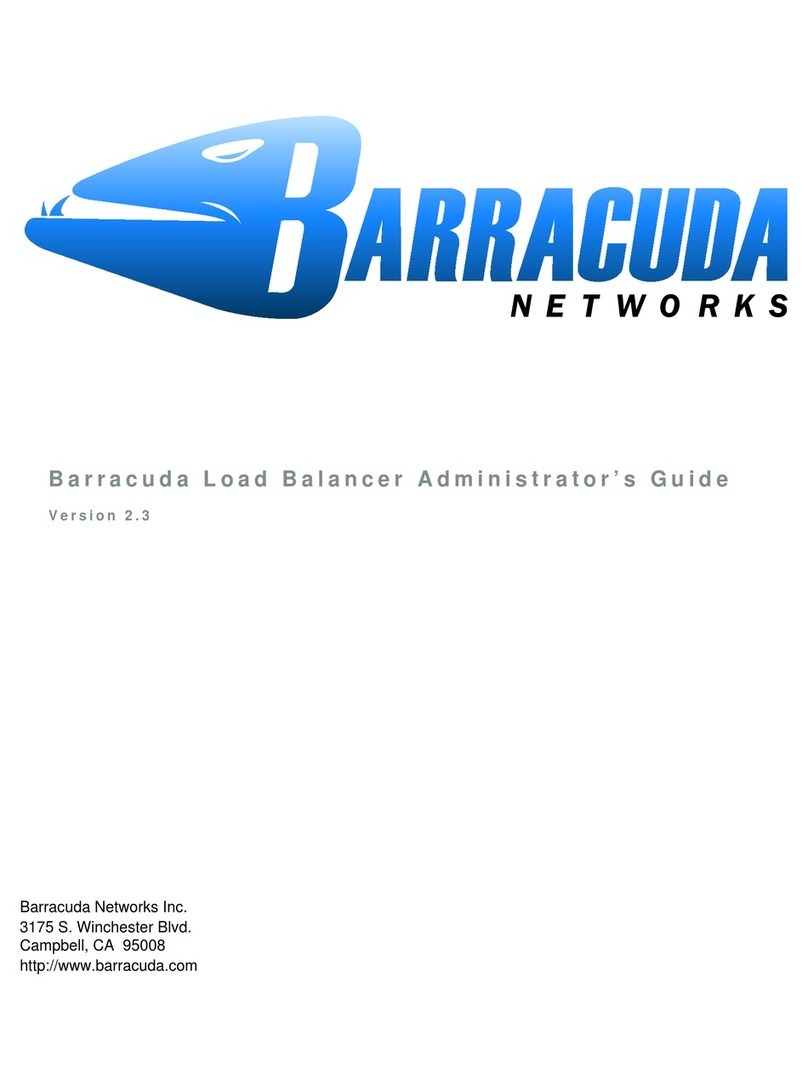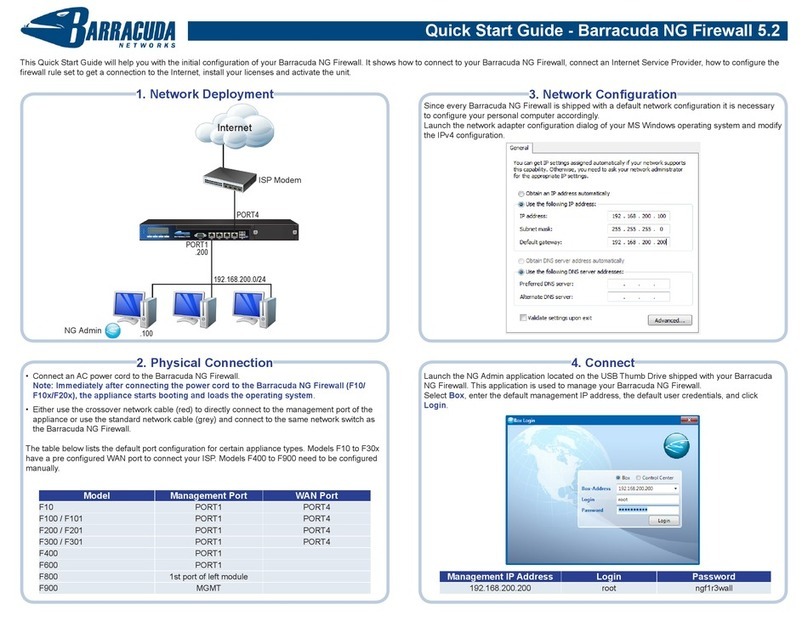Barracuda Load Balancer
B ra racuda Load Balancer - Quick Start Guide
Activate Subscription
Verify that the Energize Updates feature is activated on your Barracuda Load
Balancer – this is required to enable further configuration.
1. Go to the Basic > Status page.
2. Under Subscription Status, if Energize Updates is Not Activated, click the activation
link to be redirected to the Barracuda Networks Product Activation page. Complete
activation of your subscription(s).
If it is connected to the Internet, your Barracuda Load Balancer automatically
updates its activation status after you reload the browser page when viewing the
Basic > Status page. If your network firewall prevents your Barracuda Load
Balancer from updating its activation status automatically, you can manually
enter the activation code provided after completing the details on the Barracuda
Networks Product Activation page.
Update the Firmware
Go to Advanced > Firmware Update. If there is a new Latest General Release
available, perform the following steps to update the system firmware:
1. Click the Download Now button located next to the Latest General Release firmware
version. Click OK to acknowledge the download duration message. To avoid
damaging the Barracuda Load Balancer, do not power off during an update or
download. To view the progress of the download, click Refresh. You will be notified
when the download is complete.
2. Click Apply Now to apply the firmware. Click OK to acknowledge the reboot
message. Applying the firmware takes a few minutes to complete.
3. After the firmware has been applied, the Barracuda Load Balancer automatically
reboots. When the system comes back up, the login page is displayed. Log in again.
Change the Administrator Password
To prevent unauthorized use, we recommend you change the default
administrator password to a more secure password. You can only change the
administrator password for the Web interface. You cannot change the password
for the Administrative Console, but this is only accessible via the keyboard which
you can disconnect at any time.
1. Go to Basic > Administration and enter your old and new passwords.
2. Click Save Password.
Configure a Layer 4 Service
For each Real Server that you wish to load balance, ensure that its IP address is
within the LAN IP and subnet mask defined in Step 4, and configure its default
gateway to be the LAN IP address of the Barracuda Load Balancer. Connect the
Real Servers to the switch plugged into the LAN interface. Now create the
Service on the Barracuda Load Balancer:
1. Go to the Basic > Services page.
2. In the Service Name box, enter a name for the Service you wish to create. This is a
name you can use to identify the Service in the future, but does not affect load
balancing.
3. In the Virtual IP box, enter a Virtual IP address for the Service. This IP address will
live on the WAN interface and become the IP address used by the clients to reach the
load balanced Service. In the Port box, enter the port for the given Service. If the
Service uses multiple ports, type ALL.
4. In the Real Server box, enter the IP addresses for the Real Servers which hold the
application or content. In this scenario, these Real Servers must be on a separate
subnet from their associated Virtual IP addresses and have the Barracuda Load
Balancer’s LAN interface configured as their default gateway.
Test Connectivity
Verify network connectivity by using a machine in your existing network to
access the Service you just defined. Connect to the Virtual IP in the same way
you used to go to the single server.
For more information
More deployment and Service options are presented in detail in the Barracuda Load
Balancer Administrator’s Guide. This and other documentation is available at
http://www.barracuda.com/documentation. Be sure to check out the Barracuda
Networks Support Forum at http://forum.barracuda.com for Frequently Asked Questions
(FAQs) and other helpful tips for setting up and using your Barracuda Load Balancer.
Contact and Copyright Information
Barracuda Networks, Inc. 3175 S. Winchester Blvd., Campbell, CA 95008 USA phone: 408.342.5400 fax: 408.342.1061 www.barracuda.com
Copyright 2007-2010 Barracuda Networks, Inc. All rights reserved. Use of this product and this manual is subject to license. Information in this document is
subject to change without notice. Barracuda Load Balancer is a trademark of Barracuda Networks, Inc. All other brand and product names mentioned in this
document are registered trademarks or trademarks of their respective holders. 091203-31v0





















